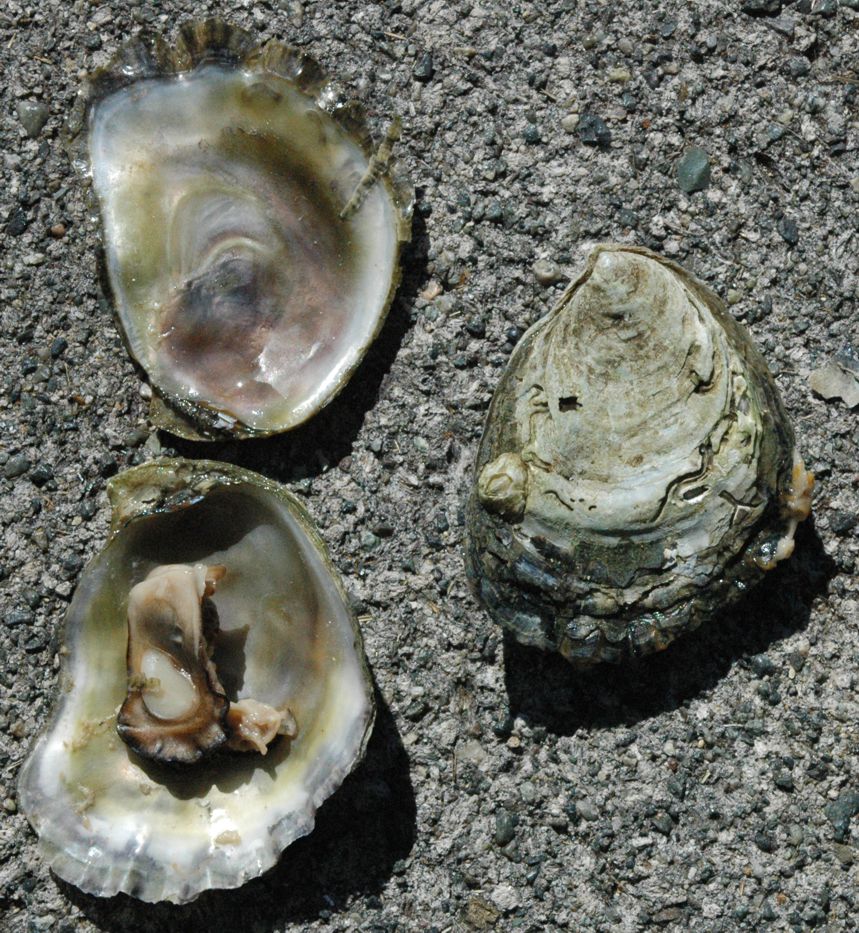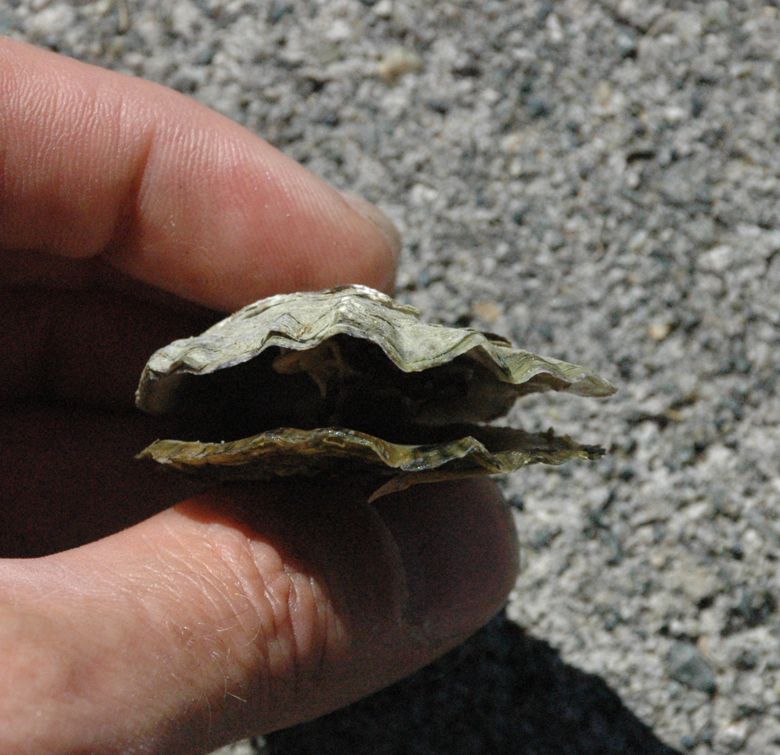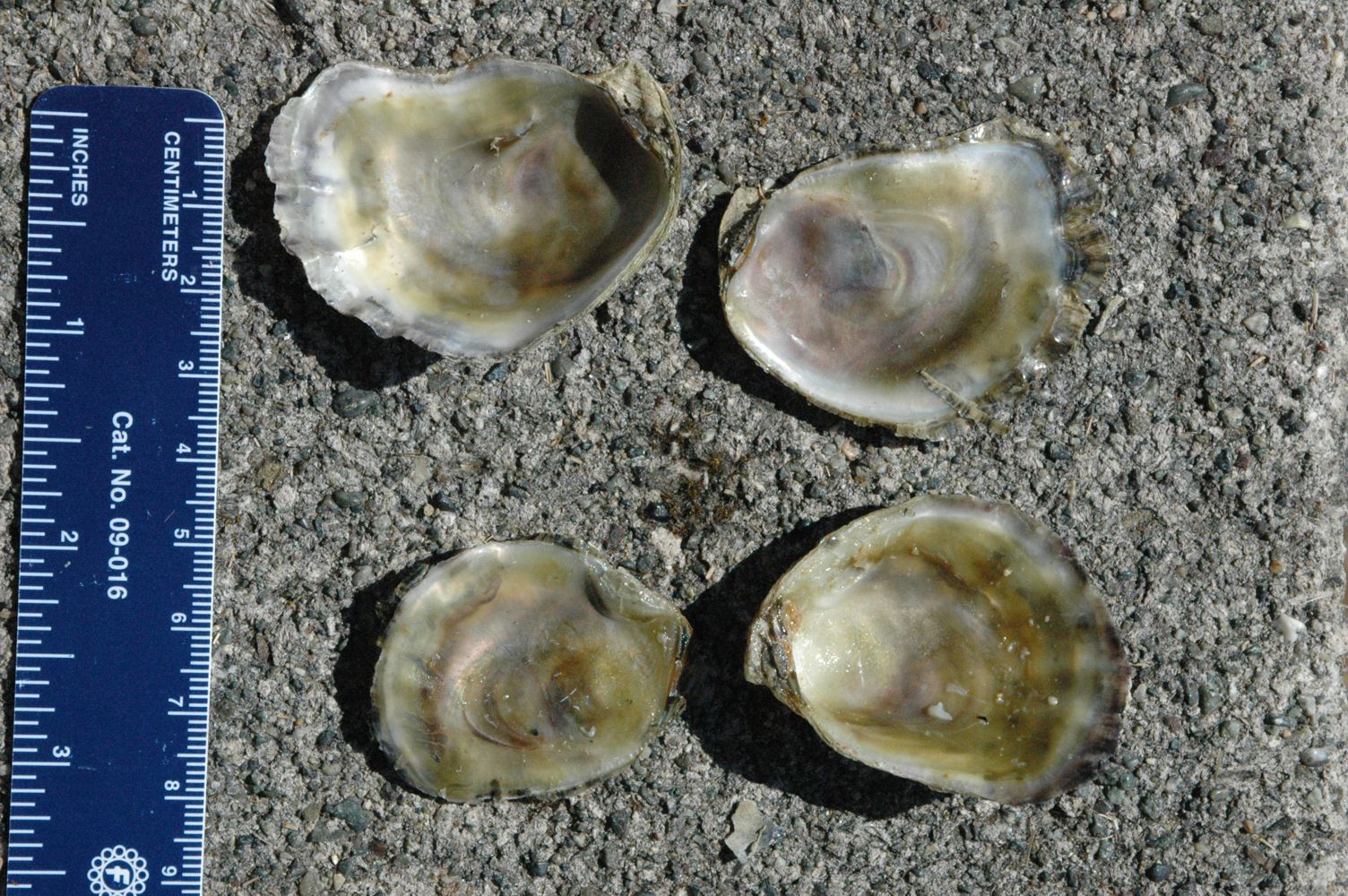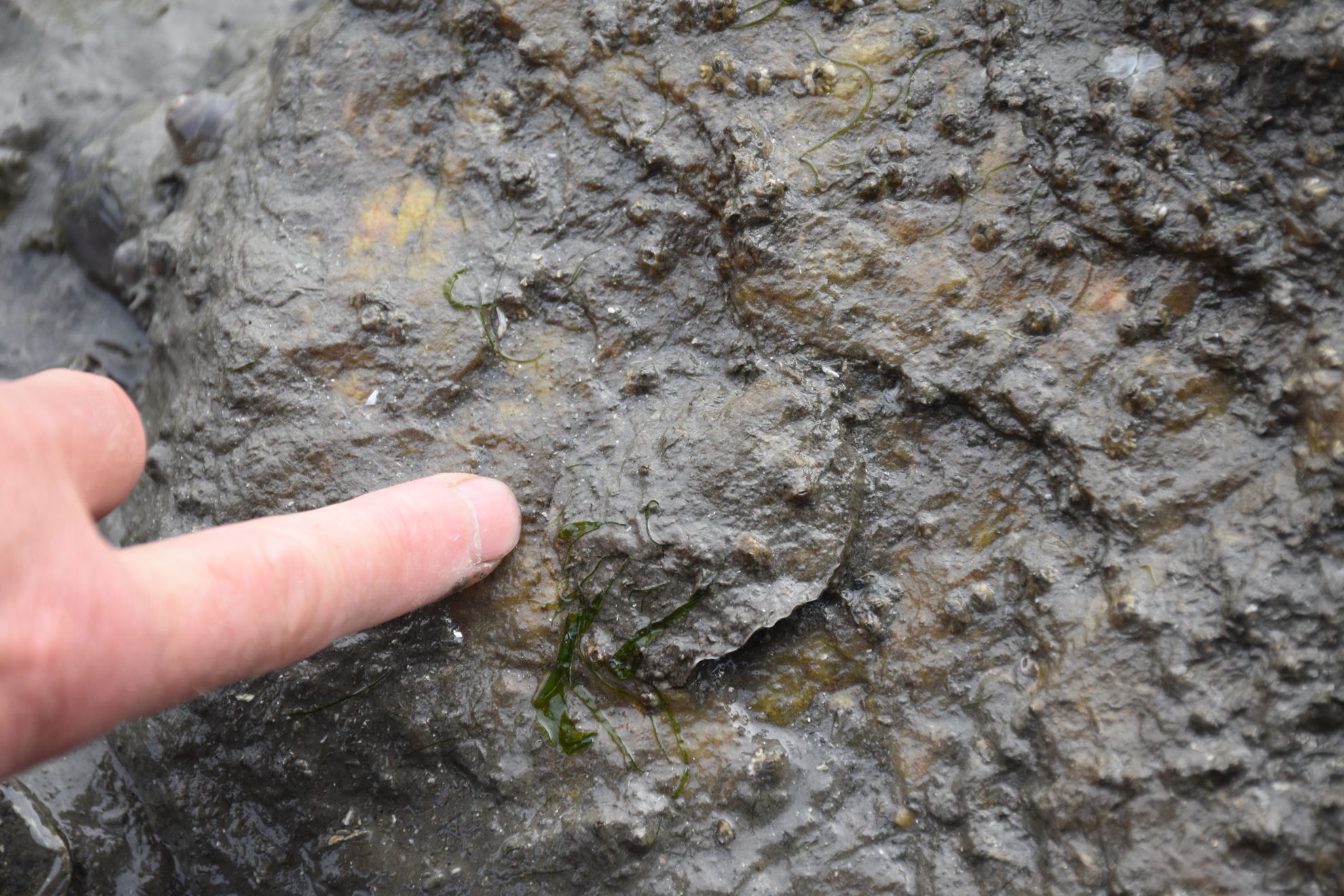Ostrea lurida Carpenter, 1864Common name(s): Olympia Oyster, Native Pacific oyster, California oyster, Lurid oyster |
|
| Synonyms: Monociostrea vancouverensis, Ostreola conchaphila[Also see note below on Ostrea conchaphila] |  |
|
Subclass
Pteriomorphia
Order Ostreida
Superfamily
Ostreoidea
Subfamily Ostreinae
|
|
| Ostrea lurida, cultivated individuals from Taylor Shellfish Farms near Rosario. These individuals are about 3 cm in length and 4 cm in height. The tissue is still present in the opened individual on the left. | |
| (Photo by: Dave Cowles, August 2016 ) | |
Description: Bivalves in Subclass Pteriomorphia typically live attached to surfaces by cementing their shell or secreting byssal threads. The foot is reduced or absent. Oysters have two thick, irregular valves, but one of them (the left) is usually cemented to the substrate. The height of the valves is usually greater than the length. The valves have no "wings" near the hinge, and have no regularly spaced radial ribs. There is only one adductor muscle scar inside the shell (photo). Genus Ostrea (flat oysters) are not as deeply cupped as are the cupped oysters (Genus Crassostrea), and they have small chomata near the ends of the hinge which Crassostrea does not have. Ostrea lurida is the only small, native oyster species normally found on our portion of the coast. It cements its left valve to a solid substrate, often a shell or rock. Its gray or white valves tend to be irregular or oval in outline and have few if any frills growing on them (although there may be irregular concentric lines). The shell is thin, and the ventral margin of the shell may be scalloped. Inside, the valves are whitish or grayish-green and slightly pearly. The height does not exceed about 8 cm, and is not usually greater than 5 or 6 cm. Takes 4-6 years to grow to 4-5 cm height. The single adductor muscle scar inside the valves is not much darker than the rest of the inside of the valve (photo).
How to Distinguish from Similar Species: Both of the other oyster species on our coast can get much larger than 8 cm. Magallana gigas can grow up to 25 cm in height, often has substantial frills on the shell, and often has a blue-black adductor muscle scar. In a few limited areas the European flat oyster, O. edulis, is cultivated, but that species has a dark adductor muscle scar and can grow to slightly larger. O. lurida looks virtually identical to O. conchaphila which is found on the west coast of Mexico near Mazatlan and further south. In fact, there are no reliable morphological features which distinguish them and some recent papers treat our local species as O. conchaphila. However, molecular evidence suggests it is indeed a separate species (Polson et al., 2009)
There is some discussion of whether the intertidal and subtidal populations of this species may in fact be separate but closely related species.
Geographical Range: Pacific coast from Sitka Alaska to central Baja California, mainly in protected bays. Common locally in Willapa Bay and south Puget Sound in our area, and cultivated in some oyster farms. Recently re-introduced to Fidalgo Bay. It is also common in San Francisco Bay and Tomales Bay in California.
Depth Range: Intertidal to 50 m depth, mostly low intertidal or shallow subtidal.
Habitat: Often in clumps on shells in mud, on rocks, concrete pilings, and on oyster shells. If living on rocks it often is near the underside unless the rocks are embedded in mud; then they are on the upper side.
Biology/Natural
History: This species
is a hermaphrodite,
meaning that it is both male and female. It tends towards
being a
protandrous
hermaphrodite, which are males when they are young and
females when
they grow larger, but for most of its life it seems to alternate
between
the sexes and both gonads may be mature at the same time. It discharges
large numbers of gametes at a time, sperm first followed by rapid
development
of eggs. The sperm are released but the eggs are fertilized
and brooded
within the valves
for several weeks. After the gametes are released the oyster's flesh is
soft, flabby, and translucent rather than firmer and whitish in color
for
a period. Spawning is usually in spring and settlement of the larvae
(spat)
in late summer, but may occur more than once in the year if
temperatures
are warm. This small oyster was heavily exploited for food and
commercial
harvest along our coast in the 1800's, leading to commercial extinction
of the species by 1930. Noting its rapid disappearance,
Washington
State placed restrictions on harvest and established marine reserves
starting
in 1897. However, the oyster has been very slow to recover
and is
still uncommon in most places. Continuing efforts are being made to
help
it recover. Some of the main barriers to its recovery include
competition
by other species, especially introduced ones, after settlement of the
spat,
its sensitivity to emersion,
and the removal of the previously existing oyster beds which provided
ideal
larval settlement conditions (Trimble
et al., 2009). In the mud flats where this species
often grows,
burrowing shrimp such as Upogebia
pugettensis and Neotrypaea
californiensis may exclude them due to the
sediment raised by
their burrowing activity (an example of amensalism).
Parasites include
several protists, including one similar to Mikrocytos
(Friedman
et al., 2005) and the ectoparasitic copepod Mytilicola
orientalis may be present as well, especially in San
Francisco Bay.
| Return to: | |||
| Main Page | Alphabetic Index | Systematic Index | Glossary |
References:
Dichotomous Keys:Carlton, 2007 (As O. conchaphila)
Flora and Fairbanks, 1966
Kozloff, 1987, 1996
General References:
Carefoot,
1977
Fitch,
1953
Harbo,
1999 (As O.
conchaphila)
Harbo,
2011
Johnson
and Snook, 1955
Kozloff,
1993
Lamb
and Hanby, 2005 (as O. conchaphila)
Morris,
1966
Morris
et al., 1980
Niesen
1994, 1997
Ricketts
et al., 1985
Sept,
1999 (as O.
conchaphila)
Scientific Articles:
Baker, P., 1995. Review of ecology and fishery of the Olympia oyster, Ostrea lurida with annotated bibliography. Journal of Shellfish Research 14: pp 501-518
Blake, Brady, and Philine S.E. Zu ermgassen, 2015. The history and decline of Ostrea lurida in Willapa Bay, WA. Journal of Shellfish Research 34:2
Cook, A.E., J.A. Shaffer, B.R. Dumbauld, and B.E. Kauffman, 2000. A plan for rebuilding stocks of Olympia oysters (Ostrea conchaphila, Carpenter, 1857) in Washington State. Journal of Shellfish Research 19: pp 409-412
Hopkins, A.E., 1935. Attachment of larvae of the Olympia oyster, Ostrea lurida, to plane surfaces. Ecology 16: pp 82-87
Hopkins, A.E., 1936. Ecological observations on spawning and early larval development in the Olympia oyster (Ostrea lurida). Ecology 17: pp 551-556
Hopkins, A.E., 1937. Experimental observations on spawning, larval development, and setting in the Olympia oyster Ostrea lurida. Bulletin of the U.S. Bureau of Fisheries 48: pp 438-503
Friedman, Carolyn S., Heather M. Brown, Timothy W. Ewing, Frederick J. Griffin, and Gary N. Cherr, 2005. Diseases of Aquatic Organisms 65: pp 1-8
Kirby, Michael Xavier, 2004. Fishing down the coast: Historical expansion and collapse of oyster fisheries along continental margins. Proceedings of the National Academy of Science 101:35 pp 13096-13099. doi 10.1073/pnas.0405150101 (as O. conchaphila)
McKernak, D.L., V. Tarter, and R. Tollefson, 1949. An investigation of the decline of the native oyster industry of the State of Washington, with special reference to the effects of sulfite pulp mill waste on the Olympia oyster (Ostrea lurida). State of Washington Department of Fisheries Biological Report 49A: pp 115-165
Polson, Maria P., William E. Hewson, Douglas J. Eernisse, Patrick K. Baker, and Danielle C. Zacherl, 2009. You say Conchaphila, I say Lurida: Molecular evidence for restricting the Olympic oyster (Ostrea lurida Carpenter) to temperate western North America. Journal of Shellfish Research 28:1 pp 11-21. doi http://dx.doi.org/10.2983/035.028.0102
Pritchard, Catherine, Alan Shanks, Rose Rimler, Mark Oates, and Steven Rumrill, 2015. The Olympia oyster Ostrea lurida: recent advances in natural history, ecology, and restoration. Journal of Shellfish Research 34:2.
Ruesink, Jennifer L., B.E. Feist, C.J. Harvey, J.S. Hong, A.C. Trimble, and L.M. Wisehart, 2006. Changes in productivity associated with four introduced species: ecosystem transformation of a 'pristine' estuary. Marine Ecology Progress Series 311: pp 203-215. doi 10.3354/meps311203
Trimble, Alan C., Jennifer L. Ruesink, and Brett R. Dumbauld, 2009. Factors preventing the recovery of a historically overexploited shellfish species, Ostrea lurida Carpenter 1864. Journal of Shellfish Research 28:1 pp 97-106. http://dx.doi.org/10.2983/035.028.0116
White, J.M., E.R. Buhle, J.L. Ruesink, and A.C. Trimble, 2009. Evaluation of native oyster (Ostrea lurida) status and restoration techniques in Puget Sound, Washington, USA. Journal of Shellfish Research 28: pp107-112. doi 10.2983/035.028.0101
Web sites:
General Notes and Observations: Locations, abundances, unusual behaviors:

In this ventral
view the slight scalloping of the valves
on the ventral
margin can be seen.

In these two opened individuals it can be seen that the adductor
muscle scar is visible but not much darker than the rest of
the internal
shell.

This individual was found under an intertidal rock. Photo by Dave Cowles, July 2020

This
individual, which is almost camouflaged, was on the underside of a rock
which was gently resting in mud in Fidalgo Bay. Photo by Dave Cowles,
August 2025

In
areas with more oxygen access, such on this gravelly beach section in
Fidalgo Bay, there are many more individuals living under rocks. Photo
by Dave Cowles, August 2025.

These two Ostrea lurida individuals (left) were attached to the underside of a Magallana gigas oyster sitting in a gravel/cobble section of beach in Fidalgo Bay. Photo by Dave Cowles, August 2025
Authors and Editors
of Page:
Dave Cowles (2017): Created original page
CSS coding for page developed by Jonathan Cowles
Salish Sea Invertebrates web site provided courtesy of Walla
Walla University